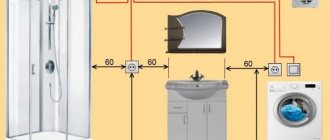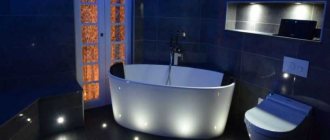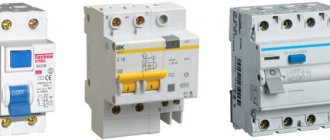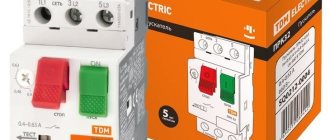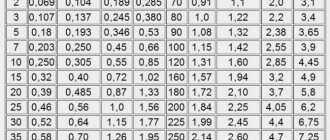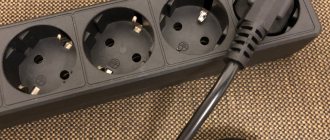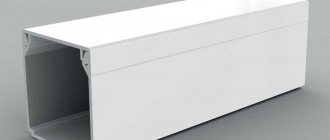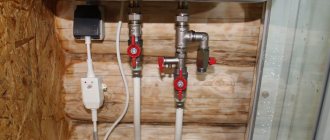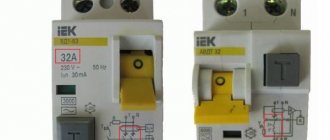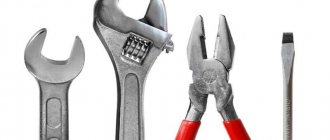Modern electrical safety requirements for a household network, whether in an apartment or a private house, provide for the installation and connection of two main types of protection. The first are circuit breakers, which protect the network from short circuits and overloads. The second element is a residual current device (RCD), which ensures the safety of human life from electric shock when touching live parts or the occurrence of leakage currents. Such protection is especially important in rooms with high humidity, that is, in the bathroom. Therefore, we will dwell in more detail on the question of how to choose an RCD for a water heater or washing machine.
Which machine should I install on my water heater?
An electric water heater can be instantaneous, or it can be storage (that is, a boiler with a tank, if it’s simpler).
Typically, instantaneous electric water heaters are more powerful household appliances (when compared with storage ones).
When choosing a machine, we first focus on the power of the device.
You can find out what power a water heater has in the product data sheet, or on the tag; the tag can be located on the back wall of the water heater.
I have a storage boiler with a capacity of 1.8 kW, so I installed a 10 Amp machine, that’s enough.
This machine can withstand a load of up to 2.2 kW.
Here is a table for your reference.
If you have a more powerful water heater (more powerful than 2.2 kW), then we install a 16 Ampere machine; such a machine can withstand a load of up to 3.5 kW (220 Volt network).
That is, the machine is selected taking into account the power of the device, this is the main guideline.
“Formula” that can be used to guide you when choosing a machine.
We multiply the boiler power by 1000 and divide by 220.
For example, you have a water heater (storage) in which a 2 kW heating element is installed.
2 x 1000: 220 = 9 (with remainder), which means you need a 10 Ampere machine (with a small margin).
Ampere is a unit of measurement of current (electrical).
The formula is simplified, but you can easily navigate it.
If the boiler is equipped with a plug, then a socket is connected to it; the socket must be grounded.
Also, in the diagram for connecting the boiler to electricity, there must be an RCD (RCD, this is a residual current device).
I bought a boiler relatively recently; more modern models can be equipped with a built-in RCD.
That is, a box is “embedded” into a standard wire (cable) and is often light in color; this is an RCD.
Older models of boilers (storage) do not have RCDs.
Also take into account the cross-section of the wire to which the water heater is connected.
Sockets are usually supplied with a wire with a cross-section of 2.5 squares (copper wire), a wire with this cross-section (copper) can withstand a load of up to 5.9 kW.
If the boiler is more powerful than 2.5 kW, then it is better to connect it separately (separate wiring from the panel) from other household appliances.
If you asked about the manufacturer of the machines, then I have a Legrand machine installed (Legrand is a European manufacturer of automatic circuit breakers, too), and there were no problems with it after several years of operation.
If the water heater is standard, it is connected to a regular outlet. Typically the outlet has a 16 amp circuit breaker. A plug is sold with water heaters. There is an RCD on the plug. There are two buttons. One on other off
if the machine is 16 amp. The power supply is 220 Volts. Power is voltage multiplied by maximum current. We get 3520 watts, which is 3.5 kW. When the power reaches 3.5 kW, the machine will have to turn off the load. You can see the maximum power in the characteristics of the water heater.
You didn't ask about the cable. What cable cross-section is needed to connect the water heater.
First of all, the machine must protect the electrical wiring; this should not be forgotten.
Therefore, the power of the machine, first of all, depends on the cross-section of the supply wire, which is connected to the water heater.
When the heater power is up to 2 kW, a 10 A automatic machine is installed; the power cable must have a cross-section of at least 1.5 square meters. mm, if the power of the device is up to 3.5 kW, then it is necessary to install an automatic machine with a rated current of 16A, and the supply cable must be three-core, with a cross-section of at least 2.5 sq. mm (meaning copper cable).
If the water heater has a power of more than 3.5 kW, it must be connected to a separate line with the corresponding machine directly (without an outlet).
It is advisable to install a two-pole circuit breaker.
The water heater must be grounded, for this a 3-wire power cable is needed.
Together with the circuit breaker, it is also necessary to install an RCD (residual current device) in the line for the water heater, and the current parameter in it must be an order of magnitude higher than the current of the circuit breaker. The device leakage current should not exceed 30mA.
In modern water heaters, the connection cable already has its own built-in RCD, then there is no point in installing an additional device.
When connecting the heater to a common outlet group, it is necessary to take into account other consumers that can work simultaneously with the heater. The wiring may not be able to handle the power.
If you are going to connect the heater through an outlet, then you need to pay special attention to the choice of outlet. The socket must be suitable for rooms with high humidity - marked IP44 or IPX4 (degree of protection).
But even waterproof sockets in damp rooms must be installed in accordance with GOST R 50571-7-701-2013, which prohibits installing sockets closer than 60 cm from a washbasin or bathroom, and the height of the socket must be 130 cm.
Wet rooms are usually divided into zones. Sockets are allowed to be installed in the third zone.
When choosing a method for connecting the water heater (into an outlet or directly), carefully read the instructions for the device. If it states that it can be connected directly or using an existing power cord, then there is no question. Otherwise, direct connection may void your water heater warranty.
Connecting to a power outlet has its advantages - if the device needs to be removed for cleaning, repairs or for another reason, you will not have to invite an electrician to unplug it, and after servicing, make a direct connection again.
Source
Scorpion. General characteristics of the zodiac sign
Tags: , automatic, ampere, boiler, sconce, view, water heater, harm, choice, switch, house, , grounding, protective, sign, cable, like, circuit, crown, , magnet, installation, multimeter, voltage, nominal, lighting, connection, potential, rule, touch, principle, wire, start, , work, resistor, repair, row, light, LED, network, system, connection, term, circuit, ten, type, current, current, three-phase, , installation, phase, photo, photoresistor, shield
How to connect a water heater to electricity - mistakes, choice of cable, socket, machines.
For a comfortable stay in the house, when you want to constantly use hot water, and not depend on the repair schedule of monopolists who can turn off this water for an unknown number of days, many people think about purchasing a boiler.
Most often, the choice falls towards a storage water heater. They come from different companies: Ariston, Drazice, Baxi, etc., shapes and designs - flat, cylindrical or elongated.
The installation of cold and hot water pipes may differ, but they are all connected to the 220V network in the same way.
Many people mistakenly believe that in order to connect the boiler, you just need to plug the plug into the socket and not worry about anything else. However, they forget that it is in the boiler that, in case of insulation failure, direct contact of electricity with a person can occur through water.
When renovating new apartments, the boiler is usually wired separately directly from the panel. If you want to connect the boiler to the old common wiring, which already has several sockets connected, be sure to make sure that it can withstand the power of the boiler.
In most cases, with a power of up to 3.5 kW, wiring must be done with a 3-core copper cable VVGnG-Ls, with a cross-section of at least 2.5 mm2.
The three-core cable is required to ensure a permanent connection to ground.
Choose a two-pole boiler connection machine. The rated current of the machine is 16A (sufficient for boiler power up to 3.5 kW).
For loads up to 2 kW, a circuit breaker with a rated current of 10 A is suitable.
If the boiler is connected from an outlet, then the outlet must have a degree of protection IP44. These are sockets for rooms with high humidity levels.
If it says that this boiler can be connected in two ways
then you will not lose the guarantee here.
In addition, if you need to dismantle the device from the wall, if there is a plug, you will not need to call an electrician to disconnect it from the power supply. Pull out the plug, take it off, rearrange it, do whatever you want.
Powerful boilers over 3.5 kW should only be connected directly through a circuit breaker; a socket connection is not allowed here.
The cable must be routed so that there are no intersections with water pipes and places where the heater will be mounted.
Leakage current for RCD – 10mA or 30mA.
Why 10mA is better and not more can be understood from this sign of the effect of current on the human body:
A significant disadvantage here is that at 10mA the protection may falsely trigger. Especially if your water heater has been hanging for more than a year and such condensation and moisture often form in the places where the terminals are connected.
How can I check if this is a false positive or if the heating element itself is faulty? To do this, use a multimeter.
Turn off the power supply or pull out the plug from the socket and disconnect the standard grounding from the titanium body.
Then remove the terminal clamps from the heating element itself, and using probes, measure the resistance between the boiler body and the heating element.
If the heating element is working properly, the readings on the multimeter screen should tend to infinity, that is, they should be something like this:
In case of breakdown and damage to the heater, they will either be zero, but most often they can be several hundred or even kiloohms. In the photo below this is exactly the option
Very often, in many of the latest boiler models, an RCD with a leakage current of 15 mA is already built into the cable for connecting to the outlet. In this case, it may not be necessary to install an additional leakage current protection device in the panel.
However, do not forget that such a built-in RCD will protect against leakage only if there is damage in the heater itself, but will not protect you in any way if there is a fault directly in the outlet or the supply wiring to it.
How to find these and other similar faults and what this can lead to can be found in the article “Electric shock in the bathroom. 5 reasons and what to do?”
What to do if you are not an expert in electricity and you yourself cannot or do not want to go into the electrical panel in order to install all the required protection devices there. But you still need to protect yourself.
Plug it into the existing outlet in the bathroom, and through it you plug the plug from the boiler cord.
Will the residual current device on the boiler trip if you do not have a ground connection? Will. These two systems, when working together, are designed to complement each other.
In the event of a current leak on a boiler without grounding, the protection device will only work when you directly touch the tank or the water from it (with the heating elements turned on).
Boiler connection diagram via socket:
Electrical diagram of the water heater:
Schematic diagram without socket directly from the panel:
This is strictly forbidden. Sockets should be placed away from the heating device and placed above the faucets. Don't forget about the safety valve and possible leaks.
The valve will operate as a last stage of protection if the thermostat fails. By the way, the thermostat needs to be checked first when the light on the panel does not light up and the heating elements do not heat up. Look at the position of the button on the element, it can be “knocked out”.
- A common mistake when connecting the device directly to an outlet is the desire to turn off the device by pulling out the plug at a time when the water has not yet warmed up and the heater is still working
If its power reaches 3.5 kW, then with such a break in the contacts, sparking may occur, with the formation of an arc. And since the bathroom is a room with high humidity, the consequences may not be predictable.
The heating element installed inside requires water cooling. Without it, it will simply burn out and fail. Therefore, before each switching on, check the presence of water in the boiler.
In general, it is not recommended to keep titanium without water. This reduces its service life. A full tank contains less oxygen, and therefore the risk of corrosion is reduced.
Plus, the magnesium anode, which also protects against rust formation, only works when the tank is full.
- connecting the water heater only through an RCD, or only through an automatic device
These two protection devices must duplicate each other. The RCD protects against leakage current, and a simple circuit breaker protects against overload and short circuits.
If your budget allows, then instead of these two protective elements you can install one differential automatic device; it will replace both devices.
Source
Operation of a difavtomat in a two-wire circuit
You need to disconnect the power cable from the load and turn it on again. Another situation is dangerous when operation does not occur in the presence of current leakage.
At a certain point, the bimetal plate gradually bends. At a certain moment it acts on the shutdown element of the protective device. How does a differential automatic machine work? Since this device in its design has two blocks with different purposes, these blocks will accordingly react differently to disturbances in the electrical circuit.
Connecting a difavtomat is almost similar to connecting an RCD. It contains several devices at once, which are installed on each group or divide the groups into several sections.
Single-phase connection of protection. For quick response, selective devices are used, which come in two classes S and G. Installation of a dedicated device but of lower power for each of the potentially unsafe lines: bathroom, kitchen, garage, basement.
Operating principles of the automatic machine
For example, at a dacha for a seasonal visit, where there are only a few sockets and lighting, it is enough to install only one difavtomat at the entrance, from which separate lines will go to groups of consumers - sockets and lighting - through the machines. The upper terminals of the device are incoming, and the lower terminals are outgoing. The result of the error is false positives of one or both systems.
Before installing them on the required section of the circuit, it is necessary to correctly determine its functionality. The second circuit is assembled without selective differential circuit breakers, so if a fault occurs in one of the apartments, the circuit breaker of this apartment will turn off, plus also the circuit breaker on the site. A flag that shows the reason for the shutdown. If the shutdown was caused by an overload, the indicator remains flush with the body, as in the photo on the right. Thus, the voltage that circulates through the network is only a volt.
Connection diagram for difavtomat
That is, if one of three violations of the electrical circuit, short circuit, overload, leakage current, appears in any group, then the protective device will immediately turn off all groups of consumers. As a rule, washing machines, electric kitchen stoves, air conditioners, and sockets with grounding contacts are powered through differential circuit breakers.
This is not worth doing. In this case, you need to find much more free space in the shield. Ideally, protective devices should operate immediately after an electrical insulation failure, and not wait until a person comes under voltage. connecting a differential machine
Why connect a water heater through an RCD?
Water heaters are used to heat water and its further use for domestic needs. The heating element is a heating element operating from a mains voltage of 220 V. As a result, one device contains 2 factors that together pose a danger to human life:
Damage to the insulation of the heating element or the wiring of the water heater leads to leakage current. Voltage from the conductive parts reaches the water tank, and from it to the body of the unit.
Additional Information. Powerful electrical consumers that use heating elements and water require connection to a grounded outlet. In this case, the power supply point must be connected to a PE wire connected to the building’s grounding loop. This also applies to compact instantaneous water heaters.
Document overview
Restrictions and conditions for admission to procurement of certain types of radio-electronic products originating from foreign countries have been determined.
A list of such products is provided. It includes photoresistors, LEDs, keyboards, printers, plotters, scanners, manipulators, tape recorders, voice recorders, video cameras, loudspeakers, lamps, chandeliers, etc.
The customer must reject all applications (final proposals) containing proposals for the supply of products from the list, provided that at least 2 applications (final proposals) that meet the requirements of the notice and (or) procurement documentation have been submitted to participate in determining the supplier.
Applications must contain proposals for the supply of domestic products/products of the EAEU countries and not contain proposals for the supply of the same type of product from the same manufacturer.
The resolution comes into force on the date of official publication, with the exception of certain provisions for which a different period is established.
To view the current text of the document and obtain complete information about the entry into force, changes and procedure for applying the document, use the search in the Internet version of the GARANT system:
Differences between RCDs and circuit breakers
On sale there are 3 similar in appearance, but different in purpose, protection devices. People often don't understand the difference between them:
The circuit breaker is designed to protect apartment electrical wiring from overloads and short-circuit currents. The device turns off the voltage if a short circuit occurs somewhere in the network between the phase and neutral wires. Or there are too many consumers connected to the outlet, whose total power exceeds the permissible limit.
The differential automatic machine also responds to overloads and short circuits. Additionally, it turns off the apartment when a differential leakage current occurs. For example, if the phase wire in the water heater is frayed and touches the grounded housing.
The residual current device reacts only to leakage currents. It will not turn off the apartment in case of overload or short circuit.
The difference between RCD and Difavtomat
Installation of a difavtomat in a single- and three-phase network
Before you start connecting the differential machine, you must press the “Test” button on its body. Thus, a current leak is artificially created, to which the device must respond by shutting down. This will ensure that the device is working properly. If the device does not turn off during the test test, it cannot be used.
In single-phase household networks, where the operating voltage is 220V, two-pole RCBOs are installed.
Connecting a difavtomat in a single-phase electrical network requires the correct connection of the neutral wires: the load zero is connected from the bottom of the device, and the power supply from the top.
Installation of a four-pole differential. a machine designed to protect a three-phase network, the operating voltage of which is 380V, is produced according to a similar principle. It should be taken into account that a three-phase (four-pole) automatic circuit breaker takes up more space in the distribution board than a single-phase one. This is due to the need to install a differential protection unit.
The housing of some types of RCBOs is marked with the designation 230/400V. Such a device can be installed in a network with either one or three phases. In the second case, these devices are mounted on consumers that use only one phase - this can be a group of sockets or individual devices.
Types of residual current devices
Manufactured RCD models differ in maximum current, shutdown speed and number of connected phases. Some devices have a shutdown delay. Others don't have it. Therefore, all such devices are usually divided according to technical characteristics.
From the point of view of leakage current, residual current devices are of 4 types:
Based on the number of protected phases, RCDs are:
According to the method of interrupting the circuit:
RCD on the power cable
Residual current devices installed on the cable are separately noted. These devices are mounted directly on the supply wire of the water heater. There is no need to buy them separately. They are usually installed next to the plug.
An electrical cable with an RCD is superior to conventional protection devices mounted on a DIN rail. To operate them, you do not need to calculate leakage currents and do unnecessary electrical work.
Selection of protective device
When choosing an RCD for a boiler, it is necessary to take into account its technical characteristics. The main ones include the following:
By working is meant the current passed through the power contacts of the protective device. It directly depends on the power of the water heater. For example, if the boiler power is 2.5 kW, then the operating current is 2500/220 = 11.4 A. It is advisable to select the RCD with a margin of operating current. In this case, a 16 A device is suitable.
The differential current (leakage) is determined from the operating current of the consumer. For a boiler with a power of 2.5 kW and a current consumption of 11.4 A, an RCD with a leakage current equal to 11.4 * 0.4 = 4.6 mA will be required. This figure is approximate. It is influenced by the length and condition of the electrical wiring. Therefore, in everyday life, residual current devices with a leakage current of 30 mA are usually installed.
Additional Information. Current leaks also exist in fully operational equipment and wires. However, their level is minimal and is about 10 μA. If the cables are old, then the leakage value increases many times. Therefore, RCDs are not recommended for use with old equipment or wiring.
Connection diagram to the water heater
According to the rules, the RCD is installed in front of the water heater. If the device is made with fasteners on a DIN rail, then it is most convenient to place it in the incoming electrical panel of the apartment.
A residual current device must be installed after the machine and the meter. The circuit is assembled in the following sequence:
If the water heater has a wire with an RCD, then it is quite possible to leave it. An additional redundant protection device would not hurt. On the contrary, the power supply system will become even safer.
Common connection errors
Connecting protection is not a difficult task. However, minimal electrical skills and an understanding of the operating principles of RCDs, automatic devices and other switchboard equipment are required. The most common mistakes are:
Errors when purchasing
The main mistake when buying a automatic rifle is the desire to protect yourself. In this connection, consumers choose devices with minimal current protection and overload. As a result, numerous false positives are observed.
Exceeding the shutdown current does not guarantee reliable shutdown at high load currents.
Competent selection of automatic protection parameters is usually carried out by specialists, who also give recommendations on the distribution of electrical circuits and the installation of a power panel. The lack of proper qualifications does not guarantee normal protection of consumers from emergency situations.
Reasons for false alarms of RCDs
The cause of false alarms of the RCD is both a malfunction of the protective device itself and problems with the water heater. When searching for a problem, it is important to find out which of these 2 nodes it is located in.
Malfunctions of the residual current device:
Additional Information. Sudden changes in room temperature can lead to condensation of moisture from the air on cold metal surfaces. Therefore, the contacts of the RCD and its internal elements, when rapidly cooled in a damp room, become covered with small drops of water. This factor can lead to false alarms of the device.
RCD trips when turned on
Here we are talking about a new boiler and RCD. The water heater and protective device were purchased at the store and installed in the proper place. The residual current device is activated the first time it is turned on.
This usually happens due to improper installation. The following points need to be checked.
Manufacturers of protective devices
Most modern water heaters are equipped with a plug with an RCD. If assembly is poor or incorrectly connected, the protective device on the cable may fail. In such a situation, there is no need to replace the entire water heater. It is enough to purchase a cable with an RCD. And here it is important to take into account the model of the water heater.
Cable with RCD for Termex water heaters
The cable length is 1.5 m. A standard Euro plug is used to connect to the network. The protective device on the Thermex cable is capable of passing current up to 10 A, which corresponds to a water heater with a power of up to 2.2 kW. The maximum leakage current declared by the manufacturer is 30 mA.
Cable for Ariston
The wire is 1 m long. The RCD is located next to the plug. There are a pair of mounting holes that allow you to screw the protective device to the wall. The maximum RCD current for Ariston water heaters reaches 10 A, which allows the use of boilers with a capacity of 2.2 kW. The protective device is set to a leakage current of 15 mA.
Grost
Universal cable with RCD, suitable for connecting water heaters and other household appliances. At one end of the cord there is a Euro plug. On the other there is a socket. Between them is a block with a residual current device. This design allows you to use the cable to connect not only water heaters, but also kettles, irons, washing machines and other devices. The device is designed for a load with a current of 16 A (3.5 kW).
Socket with RCD
Some manufacturers of electrical goods produce sockets in which an RCD is installed. Externally, they represent a normal power consumption point with two plug holes. The socket body has a “Test” button and an on/off switch.
An excellent solution if the water heater is not equipped with its own protective device and you don’t want to mess around in the electrical panel. In the future, you can plug into such an outlet any electrical appliances that are suitable in terms of power.
Socket with residual current device
Any water heater must be equipped with a protective shutdown device. This measure almost completely eliminates electric shock to a person. If the boiler cable does not have a built-in RCD, it must be purchased separately.
When choosing a protective device, you should pay attention to its maximum operating current. The second important parameter is the leakage current at which the RCD will trip and disconnect the load. When choosing protective equipment, it is better to consult an experienced electrician.
Source
